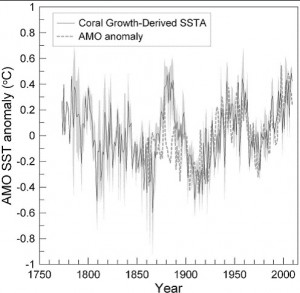Another piece of research using climate proxies has cast some light on the recent evolution of sea surface temperature in a region of the Atlantic.
The researchers, from the National University of Mexico and the Woods Hole Oceanographic Institution in the USA, writing in the journal Paleoceanography, point out that accurate low-latitude sea surface temperature records that predate the instrumental era (post-1850) are needed to put recent warming in the context of natural climate variability and to understand what they describe as the possible influence of anthropogenic climate change on this variability.
They obtain a most interesting 235-year-long sea surface temperature reconstruction based on annual growth rates of coral (Atlantic coral Siderastrea sidereal) at three sites in Mexico located within the Atlantic Warm Pool (AWP). The point out that AWP surface temperatures vary in concert the Atlantic Multidecadal Oscillation (AMO) – a basin-wide, quasiperiodic (60–80 years) oscillation of North Atlantic sea surface temperatures.
They find that the annual growth rates of all colonies are significantly, inversely correlated to regional sea surface temperatures. The temperature data they obtain shows an additional multidecadal sea surface temperature cycle prior to instrumental record that suggests that AWP multidecadal variability, and likely AMO variability, persisted since at least 1775 AD with an amplitude comparable to that of the instrumental era.
The sea surface temperature reconstruction shows that it remained within 1 deg C of recent values during the past 225 years, consistent with previous reconstructions.
The graph they produce is fascinating. It shows a decline in sea surface temperature from 1773 to 1860, then a peak at 1880 which then declines to 1910. The year 1910 is a significant one for those studying rises in sea level as it is from 1910 that the gradient of recent sea level rise changes and persists that that rate of increase to the present day.

The rise in sea surface temperature since 1910 is qualitatively the same as the rise in global surface temperature over this period, a rise between 1910 – 40, a slight decline to about 1980 and a rise thereafter.
SOURCE (See the original for links)

No comments:
Post a Comment